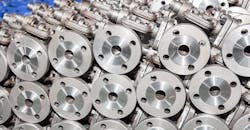Control Valve Withstands Choked-Flow Conditions Throughout its Control Range
Control valves experience significant reaction loads when they regulate choked flow. The highly restrictive, complex flow path of existing severe-service valves dissipates the forces from high-differential pressure internally. Low-restriction control valves are prone to damage by high-velocity fluid, impinging on flow path components and pressure boundary surfaces.
To solve this problem, engineers at Valve Systems International LLC, Tulsa, have developed a control valve with a least-disruptive flow path that minimizes cavitation damage and flow-induced vibration. The variable-restriction component (trim) incorporates a plug and seat made of nitrocarburized 17-4PH and 440C steel which are axially aligned with the intake and discharge ports. Unlike in other valves, the fluid does not change direction before or after the plug.
A patented helical bevel gear driven by rotation of the valve stem moves the seat as it rotates to change the annular restriction, so that vaporized fluid is always directed toward the center as it exits the trim. This means the vaporized fluid recovers pressure gradually rather than abruptly, as it does not impact flow-path surfaces and there is no risk of cavitation damage. The axis-symmetrical flow through the valve during its full range of control results in high reliability with low vibration and noise.
In operation, a multi-turn electric actuator rotates the stem in response to a control signal. The pinion gear engages the sleeve’s bevel-gear teeth, which are arranged on a helical path. Power threads on the sleeve have the same pitch as the sleeve teeth’s helix, making it move axially as it rotates. The plug, which is fixed to the intake hub of the valve body, has its contoured center portion suspended in the center by vanes on the upstream side. The distance between the seat and plug then changes to modulate the fluid flow. This makes for a high-capacity, precision-control valve suitable for high-pressure-drop, erosive flow that resists damage from cavitation.


